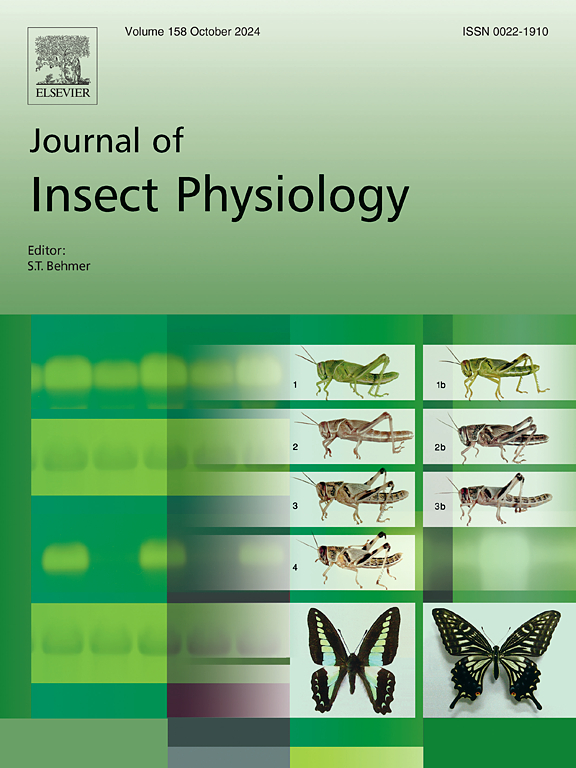Improving parasitism success of a weakly virulent parasitoid strain
IF 2.3
2区 农林科学
Q1 ENTOMOLOGY
引用次数: 0
Abstract
Endoparasitoids possess a whole set of virulence factors to counter the immune response of their host, among which can be found venom, endosymbiotic viruses and ovarian proteins. Depending on the species, some factors are expected to be less necessary than others. Notably, venom is reported as inessential in some parasitoids bearing viruses. We investigated the virulence factors of Cotesia typhae, a gregarious endoparasitoid of Sesamia nonagrioides, using highly and poorly virulent strains (CtV+ and CtV−). We tested if virulence of CtV− toward a reference strain could be improved by superparasitism (two females per host) or by injection of CtV+ virulence factors (venom and/or ovarian fluid). The parasitism success of CtV− could be increased by superparasitism with one female CtV+ confirming the importance of the virulence factors. Superparasitism with at least one CtV+ female decreased each female’s reproductive success and increased the number of non-viable offspring revealing larval competition. Parasitism order impacted the offspring proportion of each strain in the progeny, suggesting adaptation of egg-laying behavior in response to an already parasitized host. Injection of CtV+ venom or ovarian fluid alone maintained CtV− success unchanged, but their combination increased it to the one of CtV+. Altogether, this study hints towards larval competition, potentially specific to CtV+ strain, and suggests that C. typhae females can adapt their oviposition behavior based on the parasitic status of their host. It also demonstrates that, like several other Cotesia species, C. typhae resorts to a combination of venom and ovarian fluid to overcome the host’s immune responses.

提高弱毒寄生性菌株的寄生成功率。
类内寄生虫具有一整套的毒力因子来对抗宿主的免疫反应,其中包括毒液、内共生病毒和卵巢蛋白。根据物种的不同,一些因素的必要性可能不如其他因素。值得注意的是,据报道,毒液在某些携带病毒的类寄生虫中是不必要的。利用高毒力菌株(CtV+ 和CtV-)和弱毒菌株(CtV+ 和CtV-)研究了稻穗麻属(Sesamia nonagrioides)的群居性类内寄生虫——稻穗麻属(Cotesia typhae)的毒力因素。我们测试了CtV-对参考菌株的毒力是否可以通过超寄生(每个宿主两个雌性)或注射CtV+ 毒力因子(毒液和/或卵巢液)来提高。单雌CtV+ 超寄生可提高CtV-的寄生成功率,证实了毒力因素的重要性。至少有一只CtV+ 雌虫的超寄生降低了每只雌虫的繁殖成功率,增加了无法存活的后代的数量,表明幼虫竞争。寄生顺序影响了各品系在后代中所占的后代比例,表明产卵行为是对已经被寄生的寄主的适应。单独注射CtV+ 毒液或卵巢液维持CtV成功不变,但两者联合使CtV成功增加到CtV+。总之,本研究暗示了CtV+ 菌株可能特有的幼虫竞争,并表明雌性伤寒梭菌可以根据宿主的寄生状态调整其产卵行为。它还表明,像其他几种Cotesia物种一样,C. typae依靠毒液和卵巢液体的组合来克服宿主的免疫反应。
本文章由计算机程序翻译,如有差异,请以英文原文为准。
求助全文
约1分钟内获得全文
求助全文
来源期刊

Journal of insect physiology
生物-昆虫学
CiteScore
4.50
自引率
4.50%
发文量
77
审稿时长
57 days
期刊介绍:
All aspects of insect physiology are published in this journal which will also accept papers on the physiology of other arthropods, if the referees consider the work to be of general interest. The coverage includes endocrinology (in relation to moulting, reproduction and metabolism), pheromones, neurobiology (cellular, integrative and developmental), physiological pharmacology, nutrition (food selection, digestion and absorption), homeostasis, excretion, reproduction and behaviour. Papers covering functional genomics and molecular approaches to physiological problems will also be included. Communications on structure and applied entomology can be published if the subject matter has an explicit bearing on the physiology of arthropods. Review articles and novel method papers are also welcomed.
 求助内容:
求助内容: 应助结果提醒方式:
应助结果提醒方式:


